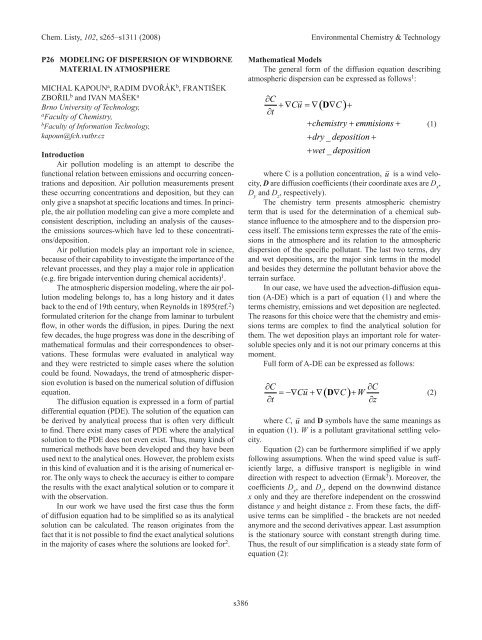2. ENVIRONMENTAL ChEMISTRy & TEChNOLOGy 2.1. Lectures
2. ENVIRONMENTAL ChEMISTRy & TEChNOLOGy 2.1. Lectures
2. ENVIRONMENTAL ChEMISTRy & TEChNOLOGy 2.1. Lectures
Create successful ePaper yourself
Turn your PDF publications into a flip-book with our unique Google optimized e-Paper software.
Chem. Listy, 102, s265–s1311 (2008) Environmental Chemistry & Technology<br />
P26 MODELING OF DISPERSION OF wINDbORNE<br />
MATERIAL IN ATMOSPhERE<br />
MICHAL KAPOUn a , RADIM DVOřáK b , FRAnTIŠEK<br />
ZBOřIL b and IVAn MAŠEK a<br />
Brno University of Technology,<br />
a Faculty of Chemistry,<br />
b Faculty of Information Technology,<br />
kapoun@fch.vutbr.cz<br />
Introduction<br />
Air pollution modeling is an attempt to describe the<br />
functional relation between emissions and occurring concentrations<br />
and deposition. Air pollution measurements present<br />
these occurring concentrations and deposition, but they can<br />
only give a snapshot at specific locations and times. In principle,<br />
the air pollution modeling can give a more complete and<br />
consistent description, including an analysis of the causesthe<br />
emissions sources-which have led to these concentrations/deposition.<br />
Air pollution models play an important role in science,<br />
because of their capability to investigate the importance of the<br />
relevant processes, and they play a major role in application<br />
(e.g. fire brigade intervention during chemical accidents) 1 .<br />
The atmospheric dispersion modeling, where the air pollution<br />
modeling belongs to, has a long history and it dates<br />
back to the end of 19th century, when Reynolds in 1895(ref. 2 )<br />
formulated criterion for the change from laminar to turbulent<br />
flow, in other words the diffusion, in pipes. During the next<br />
few decades, the huge progress was done in the describing of<br />
mathematical formulas and their correspondences to observations.<br />
These formulas were evaluated in analytical way<br />
and they were restricted to simple cases where the solution<br />
could be found. nowadays, the trend of atmospheric dispersion<br />
evolution is based on the numerical solution of diffusion<br />
equation.<br />
The diffusion equation is expressed in a form of partial<br />
differential equation (PDE). The solution of the equation can<br />
be derived by analytical process that is often very difficult<br />
to find. There exist many cases of PDE where the analytical<br />
solution to the PDE does not even exist. Thus, many kinds of<br />
numerical methods have been developed and they have been<br />
used next to the analytical ones. However, the problem exists<br />
in this kind of evaluation and it is the arising of numerical error.<br />
The only ways to check the accuracy is either to compare<br />
the results with the exact analytical solution or to compare it<br />
with the observation.<br />
In our work we have used the first case thus the form<br />
of diffusion equation had to be simplified so as its analytical<br />
solution can be calculated. The reason originates from the<br />
fact that it is not possible to find the exact analytical solutions<br />
in the majority of cases where the solutions are looked for 2 .<br />
s386<br />
Mathematical Models<br />
The general form of the diffusion equation describing<br />
atmospheric dispersion can be expressed as follows 1 :<br />
∂ C <br />
+ ∇ Cu = ∇( D∇<br />
C)<br />
+<br />
∂t<br />
+ chemistry + emmisions +<br />
+ dry _ deposition +<br />
+ wet _ deposition<br />
where C is a pollution concentration, u is a wind velocity,<br />
D are diffusion coefficients (their coordinate axes are D x ,<br />
D y and D z , respectively).<br />
The chemistry term presents atmospheric chemistry<br />
term that is used for the determination of a chemical substance<br />
influence to the atmosphere and to the dispersion process<br />
itself. The emissions term expresses the rate of the emissions<br />
in the atmosphere and its relation to the atmospheric<br />
dispersion of the specific pollutant. The last two terms, dry<br />
and wet depositions, are the major sink terms in the model<br />
and besides they determine the pollutant behavior above the<br />
terrain surface.<br />
In our case, we have used the advection-diffusion equation<br />
(A-DE) which is a part of equation (1) and where the<br />
terms chemistry, emissions and wet deposition are neglected.<br />
The reasons for this choice were that the chemistry and emissions<br />
terms are complex to find the analytical solution for<br />
them. The wet deposition plays an important role for watersoluble<br />
species only and it is not our primary concerns at this<br />
moment.<br />
Full form of A-DE can be expressed as follows:<br />
∂C <br />
∂C<br />
= −∇ Cu + ∇( D∇<br />
C) + W<br />
∂t ∂z<br />
where C, u and D symbols have the same meanings as<br />
in equation (1). W is a pollutant gravitational settling velocity.<br />
Equation (2) can be furthermore simplified if we apply<br />
following assumptions. When the wind speed value is sufficiently<br />
large, a diffusive transport is negligible in wind<br />
direction with respect to advection (Ermak 3 ). Moreover, the<br />
coefficients D y , and D z , depend on the downwind distance<br />
x only and they are therefore independent on the crosswind<br />
distance y and height distance z. From these facts, the diffusive<br />
terms can be simplified - the brackets are not needed<br />
anymore and the second derivatives appear. Last assumption<br />
is the stationary source with constant strength during time.<br />
Thus, the result of our simplification is a steady state form of<br />
equation (2):<br />
(1)<br />
(2)

















